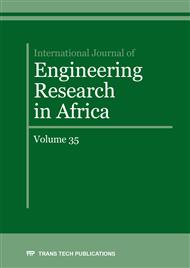[1]
Jing Yin, Xiao-xiong Zha, Long-yuan Li., Fire resistance of axially loaded concrete filled steel tube columns, Journal of Constructional Steel Research. 62 (2006) 723–729.
DOI: 10.1016/j.jcsr.2005.11.011
Google Scholar
[2]
Ana Espinos, Leroy Gardner, Manuel L.Romero, Antonio Hospitaler., Fire behaviour of concrete filled elliptical steel columns, Thin-Walled Structures. 49 (2011) 239–255.
DOI: 10.1016/j.tws.2010.10.008
Google Scholar
[3]
X.H. Dai, D. Lam., Shape effect on the behaviour of axially loaded concrete filled steel tubular stub columns at elevated temperature, Journal of Constructional Steel Research.73 (2012) 117–127.
DOI: 10.1016/j.jcsr.2012.02.002
Google Scholar
[4]
Kodur V.K.R, MacKinnon D.H., Design of concrete-filled hollow structural steel columns for fire endurance, Engineering Journal-AISC.37 (2000) 13-24.
DOI: 10.1016/s0143-974x(98)80034-5
Google Scholar
[5]
Peter Schaumann, Venkatesh Kodur, Oliver Bahr., Fire behaviour of hollow structural section steel columns filled with high strength concrete, Journal of Constructional Steel Research. 65 (2009) 1794_1802.
DOI: 10.1016/j.jcsr.2009.04.013
Google Scholar
[6]
J.C. Dotreppe,Thi Binh Chu, J.M. Franssen., Steel hollow columns filled with self-compacting concrete under fire conditions, 3rd fib International Congress, Washington, DC, USA , May, (2010).
Google Scholar
[7]
X.X. Zha., FE analysis of fire resistance of concrete filled CHS columns, Journal of Constructional Steel Research. 59 (2003) 769–779.
DOI: 10.1016/s0143-974x(02)00059-7
Google Scholar
[8]
Ana Espinos, Manuel L. Romero, Antonio Hospitaler., Simple calculation model for evaluating the fire resistance of unreinforced concrete filled tubular columns, Engineering Structures. 42 (2012) 231–244.
DOI: 10.1016/j.engstruct.2012.04.022
Google Scholar
[9]
Kyungsoo Chunga, Suhee Parkb, Sungmo Choi., Material effect for predicting the fire resistance of concrete-filled square steel tube column under constant axial load, Journal of Constructional Steel Research. 64 (2008) 1505–1515.
DOI: 10.1016/j.jcsr.2008.01.002
Google Scholar
[10]
Sangdo Hong, Amit H. Varma., Analytical modeling of the standard fire behavior of loaded CFT columns, Journal of Constructional Steel Research. 65 (2009) 54_69.
DOI: 10.1016/j.jcsr.2008.04.008
Google Scholar
[11]
Hua Yang, Faqi Liu, Leroy Gardner., Performance of concrete-filled RHS columns exposed to fire on 3 sides, Engineering Structures. 56 (2013) 1986–(2004).
DOI: 10.1016/j.engstruct.2013.08.019
Google Scholar
[12]
C. Renaud, J.M. Aribert, B. Zhao., Advanced numerical model for the fire behaviour of composite columns with hollow steel section, Steel and Composite Structures. 3 (2003) 75-95.
DOI: 10.12989/scs.2003.3.2.075
Google Scholar
[13]
J. Ding, Y.C. Wang., Realistic modelling of thermal and structural behaviour of unprotected concrete filled tubular columns in fire, Journal of Constructional Steel Research. 64 (2008) 1086–1102.
DOI: 10.1016/j.jcsr.2007.09.014
Google Scholar
[14]
Zhong Tao, Lin-Hai Han, Brian Uy and Xian Chen., Post-fire bond between the steel tube and concrete in concrete-filled steel tubular columns, Journal of Constructional Steel Research. 67 (2011) 484–496.
DOI: 10.1016/j.jcsr.2010.09.006
Google Scholar
[15]
Almand K. Structural Fire Resistance Experimental Research Priority – Needs of U.S. Industry, Final Report. The Fire Protection Research Foundation (FPRF), (2010).
DOI: 10.1007/978-1-4614-8112-6
Google Scholar
[16]
John Gales, Cristián Maluk, Luke Bisby., Structural fire testing - Where are we, How did we get here, and where are we going?, 15th International Conference on Experimental Mechanics, Porto/Portugal, July, (2010).
DOI: 10.1097/00005650-199501001-00002
Google Scholar
[17]
Fike RS, Kodur VKR., An approach for evaluating the fire resistance of CFHSS columns under design fire scenarios, Journal of Fire Protection Engineering.19 (2009) 229–259.
DOI: 10.1177/1042391509105597
Google Scholar
[18]
Lin-Hai Han, You-Fu Yang, Hua Yang, Jing-si Huo., Residual strength of concrete-filled RHS columns after exposure to the ISO-834 standard fire, Thin-Walled Structures. 40 (2002) 991–1012.
DOI: 10.1016/s0263-8231(02)00044-7
Google Scholar
[19]
Lin-Hai Han,You-Fu Yang, Lei Xu., An experimental study and calculation on the fire resistance of concrete-filled SHS and RHS columns, Journal of Constructional Steel Research. 59 (2003) 427-452.
DOI: 10.1016/s0143-974x(02)00041-x
Google Scholar
[20]
Lin-Hai Han, Jing-Si Huo and Yong-Chang Wang., Compressive and flexural behaviour of concrete filled steel tubes after exposure to standard fire, Journal of Constructional Steel Research. 61 (2005) 882–901.
DOI: 10.1016/j.jcsr.2004.12.005
Google Scholar
[21]
David I. Rush, Luke A. Bisby, Allan Jowsey and Barbara Lane., Residual capacity of fire-exposed concrete-filled steel hollow section columns, Engineering Structures. 100 (2015) 550-563.
DOI: 10.1016/j.engstruct.2015.06.039
Google Scholar
[22]
Wald F, Kallerova P. Draft summary of results from fire test in Mokrsko 2008. Prague: Ceska technika, (2009).
Google Scholar
[23]
M.S Dimia, M Guenfoud and J.M Franssen., Collapse of concrete columns during and after the cooling phase of a fire, Journal of Fire Protection Engineering.0 (2011) 1-19.
DOI: 10.1177/1042391511423451
Google Scholar
[24]
David Rush et al,. Towards fragility analysis for concrete buildings in fire: residual capacity of concrete columns, 8th International Conference on Structures in Fire, Shanghai, China, June, (2014).
Google Scholar
[25]
EN 1991-1-2. Eurocode 1: Actions on structures – Part 1–2: General actions – Actions on structures exposed to fire, Brussels, (2002).
DOI: 10.1002/9783433601570.oth1
Google Scholar
[26]
Franssen J-M., SAFIR: A thermal/structural program for modeling structures under fire, Engineering Journal – American Institute of Steel Construction Inc. 42 (2005) 143–158.
Google Scholar
[27]
Renaud Christophe. Modélisation numérique, expérimentation et dimensionnement pratique des poteaux mixtes avec profil creux exposés à l'incendie , thèse présentée à l'INSA-Rennes, France, (2003).
Google Scholar
[28]
EN 1994-1-2. Eurocode 4: Design of composite steel and concrete structures. Part 1–2: General rules – Structural fire design, Brussels, (2005).
DOI: 10.3403/30111111
Google Scholar
[29]
EN 1992-1-2. Eurocode 2: Design of concrete structures – Part 1-2: General rules – Structural fire design, Brussels, (2004).
Google Scholar
[30]
Schneider U. Properties of Materials at High Temperatures: Concrete. RILEM, University of Kassel, (1985).
Google Scholar
[31]
Li. Yi-Hai, J-M Franssen., Test results and model for the residual compressive strength of concrete after a fire, J. of Struct. Fire Eng. 2 (2011) 29-44.
DOI: 10.1260/2040-2317.2.1.29
Google Scholar
[32]
EN 1994-1-1. Eurocode 4 – Design of composite steel and concrete structures. Part 1–1: General rules and rules for buildings, Brussels, (2004).
DOI: 10.1680/dgte4.31517
Google Scholar
[33]
Zhong Tao, Mohamed Ghannam, Tian-Yi Song, Lin-Hai Han., Experimental and numerical investigation of concrete-filled stainless steel columns exposed to fire, Journal of Constructional Steel Research. 118 (2016) 120-134.
DOI: 10.1016/j.jcsr.2015.11.003
Google Scholar
[34]
Firehouse.com. Seven Swiss firefighters die in collapsed parking garage. 2004. http:// www.firehouse.com/news/lodd/seven-swiss-firefighters-die-collapsed-parking-garage.
Google Scholar


